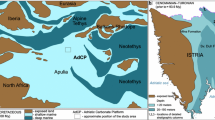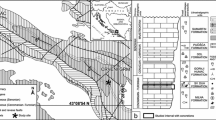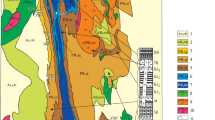Abstract
Study of the microstructure and isotopic composition of authigenic tubule-shaped carbonate concretions from sediment core PS51/154-11 on the western Laptev Sea continental slope (present water depth 270 m) has allowed for reconstruction of the conditions prevailing during their formation and identification of the mechanisms controlling their genesis. Concretions were collected from the basal sediment unit with an extrapolated age estimate of 16.3–17.6 cal.ka. Crystallization of carbonate tubules occurred at the beginning of the last deglaciation when the site was located in the proximity to the former coastline and the mouths of the Olenek and Anabar-Khatanga rivers in water depths of about 150–170 m. Microprobe analysis showed that the studied carbonate tubules consist of the minerals belonging to the siderite–rhodochrosite isomorphic series. The measured isotopic composition of δ13С and δ18O in the carbonates varies between − 21.0 and − 17.0‰ and between − 9.86 and 1.72‰ VPDB, respectively. The δ18O values in the authigenic carbonates give evidence for the gradual transition from a freshwater affected to modern-like marine sedimentation environment during carbonate crystallization. Water freshening is confirmed by the co-occurrence of authigenic Fe–Mn carbonates and Fe-phosphate vivianite that is a typical mineral of freshwater environments. The dominant source of dissolved inorganic carbon in the pore water was the isotopically light carbon derived from the diagenetic decomposition of organic matter. Two possible scenarios of authigenic carbonates formation are proposed: penetration of freshened ground waters and/or enhanced freshwater influence during short seasonal floods in combination with geochemical processes in a narrow marginal filter zone that was located extremely close to the Laptev Sea continental slope and the studied core site.




Similar content being viewed by others
References
Alekseevskii NI, Chalov SR (2009) Hydrological functions of a divided channel. Moscow (in Russian)
Antipin V, Afonina T, Badalov O, Bezrukova E, Bukharov A, Bychinsky V, Williams D, Gvozdkov A, Geletiy V, Golubev V, Goregljad A, Gorokhov I, Dmitriev A, Dorofeeva R, Duchkov A, Esipko O, Ivanov E, Yoshoda N, Kawai T, Kalashnikova I, Kalmichkov G, Karabanov E, Kerber E, King J, Konstantinov K et al (2000) Paleoclimatic record in the late Cenozoic sediments of Lake Baikal (by 600 m deep-drilling data). The Baikal Drilling Project group. Russ Geol Geophys 41(1):3–32
Bauch D, Hölemann J, Andersen N, Dobrotina E, Nikulina A, Kassens H (2011) The Arctic shelf regions as a source of freshwater and brine-enriched waters as revealed from stable oxygen isotopes. Polarforschung 80(3):127–140. https://doi.org/10013/epic.38389.d001
Bauch HA, Erlenkeuser H, Bauch D, Mueller-Lupp T, Taldenkova E (2004) Stable oxygen and carbon isotopes in modern benthic foraminifera from the Laptev Sea shelf: implications for reconstructing proglacial and profluvial environments in the Arctic. Mar Micropaleontol 51(3–4):285–300. https://doi.org/10.1016/j.marmicro.2004.01.002
Bauch HA, Mueller-Lupp T, Taldenkova E, Spielhagen RF, Kassens H, Grootes PM, Thiede J, Heinemeier J, Petryashov VV (2001)Chronology of the Holocene transgression at the North Siberian margin. Global Planet Change 31(1–4):125–139. https://doi.org/10.1016/S0921-8181(01)00116-3
Beal EJ, House CH, Orphan VJ (2009) Manganese- and iron dependent marine methane oxidation. Science. https://doi.org/10.1126/science.1169984
Becker RH, Clayton RN (1976) Oxygen isotope study of a Precambrian banded iron-formation, Hamersley Range, Western Australia. Geochim Cosmochim Acta 40:1153–1165. https://doi.org/10.1016/0016-7037(76)90151-4
Bhattacharya JP, MacEachern JA (2009) Hyperpycnal rivers and prodeltaic shelves in the Cretaceous seaway of North America. J Sediment Res 79:184–209. https://doi.org/10.2110/jsr.2009.026
Bohrmann G, Thiede J (1989) Diagenesis in Eocene claystones, ODP Site 647, Labrador Sea: formation of complex authigenic carbonates, smectites, and apatite. In: Srivastava SP, Arthur MA, Clement B et al (eds) Proc Ocean Drill Program Sci Res 105:137–154. https://doi.org/10013/epic.10975
Böttcher ME (1996) 18O/16O and 13C/12C fractionation during the reaction of carbonates with phosphoric acid: effects of cationic substitution and reaction temperature. Isot Environ Health Stud 32(2–3):299–305. https://doi.org/10.1080/10256019608036323
Burns SJ (1997) Early diagenesis in Amazon Fan sediments. In: Flood RD, Piper DJW, Klaus A, Peterson LC (eds) Proc Ocean Drill Program Sci Res 155:497–504 https://doi.org/10.2973/odp.proc.sr.155.236.1997
Canfield DE, Raiswell R, Bottrell SH (1992) The reactivity of sedimentary iron minerals toward sulfide. Am J Sci 292:659–683. https://doi.org/10.2475/ajs.292.9.659
Chow N, Morad S, Al-Aasm IS (1996) Origin of authigenic carbonates in Eocene to Quaternary sediments from the Arctic Ocean and Norwegian-Greenland Sea. In: Thiede J, Myhre AM, Firth JV, Johnson GL, Ruddiman WF (eds) Proc Ocean Drill Program Sci Results 151:415–434. https://doi.org/10.2973/odp.proc.sr.151.145.1996
Chow N, Morad S, Al-Aasm IS (2000) Origin of authigenic Mn Fe carbonates and pore-water evolution in marine sediments: Evidence from Cenozoic strata of the Arctic Ocean and Norwegian Greenland Sea (ODP Leg 151). J Sediment Res 70:682–699. https://doi.org/10.1306/2DC40930-0E47-11D7-8643000102C1865D
Claypool GF, Lorenson TD, Johnson CA (2004) Authigenic carbonates, methane generation, and oxidation in continental rise and shelf sediments, ODP Leg 188 Sites 1165 and 1166 offshore Antarctica (Prydz Bay). In: Cooper AK, O’Brien PE, Richter C (eds) Proc Ocean Drill Program Sci Results 188:1–15. https://doi.org/10.2973/odp.proc.sr.188.004.2003
Council TC, Bennet PC (1993) Geochemistry of ikaite formation at Mono Lake, California: implications for the origin of tufa mounds. Geology 21:971–974
Das Sharma S, Patil DJ, Gopalan K (2002) Temperature dependence of oxygen isotope fractionation of CO2 from magnesite-phosphoric acid reaction. Geochim Cosmochim Acta 66:589–593
Dieckmann GS, Nehrke G, Uhlig C, Göttlicher J, Gerland S, Granskog MA, Thomas DN (2010) Brief Communication: Ikaite (CaCO3·6H2O) discovered in Arctic sea ice. The Cryosphere 4:227–230. https://doi.org/10.5194/tc-4-227-2010
Fagel N, Alleman LY, Granina L, Hatert F, Thamo-Bozso E, Cloots R, André L (2005) Vivianite formation and distribution in Lake Baikal sediments. Global Planet Change 46(1–4):315–336. https://doi.org/10.1016/j.gloplacha.2004.09.022
Frederichs T, von Dobeneck T, Bleil U, Dekkers MJ (2003) Towards the identification of siderite, rhodochrosite, and vivianite in sediments by their low-temperature magnetic properties. Phys Chem Earth Part A/B/C 28(18–19):669–679. https://doi.org/10.1016/S1474-7065(03)00121-9
Galimov EM (1999) The causes of the global variations of carbon isotopic composition in the biosphere. Geochem Int 37(8):699–713
Haese RR, Wallmann K, Dahmke A, Kretzmann U, Muuller PJ, Schulz HD (1997) Iron species determination to investigate early diagenetic reactivity in marine sediments. Geochim Cosmochim Acta 61(1):63–72. https://doi.org/10.1016/S0016-7037(96)00312-2
Henrich R (1989) Diagenetic environments of authigenic carbonates and opal-CT crystallization in Lower Miocene to Upper Oligocene deposits of the Norwegian Sea (ODP Site 643, Leg 104). In: Eldholm O, Thiede J, Taylor E et al (ed) Proc Ocean Drill Program Sci Res 104:233–247. https://doi.org/10.2973/odp.proc.sr.104.119.1989
Hoefs J (2015) Stable isotope geochemistry, 7th end Springer International Publishing, Switzerland. https://doi.org/10.1007/978-3-319-19716-6
Hölemann JA, Kirillov S, Klagge T, Novikhin A, Kassens H, Timokhov L (2011) Near-bottom water warming in the Laptev Sea in response to atmospheric and sea ice conditions in 2007. Polar Res 30(1):6425. https://doi.org/10.3402/polar.v30i0.6425
Hörner T, Stein R, Fahl K, Birgel D (2016) Post-glacial variability of sea ice cover, river run-off and biological production in the western Laptev Sea (Arctic Ocean)—a high-resolution biomarker study. Quat Sci Rev 143:133–149. https://doi.org/10.1016/j.quascirev.2016.04.011
Housen BA, Banerjee SK, Moskowitz BM (1996) Low-temperature magnetic properties of siderite and magnetite in marine sediments. Geophys Res Lett 23:2843–2846
Jilbert T, Slomp CP (2013) Iron and manganese shuttles control the formation of authigenic phosphorus minerals in the euxinic basins of the Baltic Sea. Geochim Cosmochim Acta 107:155–169
Karim A, Pe-Piper G, Piper DJW (2010) Controls on diagenesis of Lower Cretaceous reservoir sandstones in the western Sable Subbasin, offshore Nova Scotia. Sediment Geol 224(1–4):65–83. https://doi.org/10.1016/j.sedgeo.2009.12.010
Kim S-T, Jung OK, Seong-Taek Y, O’Neil JR, Mucci A (2009) Experimental studies of oxygen isotope fractionation between rhodochrosite (MnCO3) and water at low temperatures. Geochim Cosmochim Acta 73:4400–4408. https://doi.org/10.1016/j.gca.2009.04.018
Klyuvitkina TS, Bauch HA (2006) Holocene changes in paleohydrological conditions in the Laptev Sea based on aquatic palynomorph assemblages. Oceanology 46(6):859–868. https://doi.org/10.1134/S0001437006060117
Kodina LA, Tokarev VG, Vlasova LN, Korobeinik GS (2003) Contribution of biogenic methane to ikaite formation in the Kara Sea: Evidence from the stable carbon isotope geochemistry. In: Stein R, Fahl K, Fuetterer DK, Galimov EM, Stepanets OV (eds) Siberian River Run-Off in the Kara Sea. Characterization, quantification, variability, and environmental significance. Proc Mar Sci (6):349–375
Konhauser KO (1998) Diversity of bacterial iron mineralization. Earth Sci Rev 43:91–121. https://doi.org/ https://doi.org/10.1016/S0012-8252(97)00036-6
Konstantinova T, Cherkashov G, Hein JR, Mirão J, Dias L, Madureira P, Kuznetsov V, Maksimov F (2017) Composition and characteristics of the ferromanganese crusts from the western Arctic Ocean. Ore Geol Rev 87:88–99. https://doi.org/10.1016/j.oregeorev.2016.09.011
Kopf A, Sample JC, Bauer P, Behrmann JH, Erlenkeuser H (1995) Diagenetic carbonates from Cascadia Margin: textures, chemical composition, and oxygen and carbon stable isotope signatures. In: Carson B, Westbrook GK, Musgrave RJ, Suess E (ed) Proc Ocean Drill Program Sci Res 146(1):117–136. https://doi.org/10.2973/odp.proc.sr.146-1.234.1995
Kosheleva VA, Yashin DS (1999) The bottom sediments of the Russia Arctic Seas. VNIIOkeangeologiya, Saint-Petersburg (Russian)
Kravchyshina MD, Lein AYU, Savvichev AS, Reykhard LE, Dara OM, Flint MV (2017) Authigenic Mg-calcite at a cold methane seep site in the Laptev Sea. Oceanology 57(1):174–191. https://doi.org/10.1134/S0001437017010064
Krylov A, Minami H, Hachikubo A, Shoji H, Khlystov O, Zemskaya T, Pogodaeva T, Kida M, Naudts L, Poort J (2008) Crystallization of authigenic carbonates in mud volcanoes at lake Baikal. Geochem Int 46(10):985–995. https://doi.org/10.1134/S0016702908100030
Krylov AA, Andreeva IA, Vogt C, Backman J, Krupskaya VV, Grikurov GE, Moran K, Shoji H (2008) A shift in heavy and clay mineral provenance indicates a middle Miocene onset of a perennial sea ice cover in the Arctic Ocean. Paleoceanography 23:PA1S06. https://doi.org/10.1029/2007PA001497
Krylov AA, Khlystov OM, Hachikubo A, Minami H, Nunokawa Y, Shoji H, Zemskaya TI, Naudts L, Pogodaeva TV, Kida M, Kalmychkov GV, Poort J (2010) Isotopic composition of dissolved inorganic carbon in the subsurface sediments of gas hydrate-bearing mud volcanoes, Lake Baikal: Implications for methane and carbonate origin. Geo-Mar Lett 30(3/4):427–437. https://doi.org/10.1007/s00367-010-0190-2
Krylov AA, Khlystov OM, Hachikubo A, Minami H, Pogodaeva TV, Zemskaya TI, Krzhizhanovskaya MG, Muzafarova LE, Atanyazov RZh (2017) Mechanism of authigenic rhodochrosite formation in the near-bottom sediments of the Saint-Petersburg-2 gas-hydrate-bearing structure (central basin of the Baikal Lake). Neftegazovaya Geologiya Teoriya I Praktika 12(1) http://www.ngtp.ru/rub/12/8_2017.pdf. https://doi.org/10.17353/2070-5379/8_2017 (in Russian)
Krylov AA, Logvina EA, Matveeva TM, Prasolov EM, Sapega VF, Demidova AL, Radchenko MS (2015) Ikaite (CaCO3·6H2O) in bottom sediments of the Laptev Sea and the role of anaerobic methane oxidation in this mineral-forming process. Proc Russian Mineral Soc 4:61–75 (in Russian)
Kuleshov V (2017) Chap. 2—manganese carbonates in modern sediments. In: Maynard JB, Kuleshov V (eds) Isotope Geochemistry. The origin and formation of manganese rocks and ores, 1st end. Elsevier, pp 5–62. https://doi.org/10.1016/B978-0-12-803165-0.00002-1
Kurchatova AN, Rogov VV (2013) Authigenic carbonates of the ice complex deposits of the coastal lowlands, east Arctic. Earth’s Cryosphere 17(3):60–69 (Russian)
Kwon EY, Kim G, Primeau F, Moore WS, Cho HM, DeVries T, Sarmiento JL, Charette MA, Cho Y-Ki (2014) Global estimate of submarine groundwater discharge based on an observationally constrained radium isotope model. Geophys Res Lett 41(23):8438–8444. https://doi.org/10.1002/2014GL061574
Lein AYu (2004) Authigenic carbonate formation in the Ocean. Lithol Min Resour 39(1):1–30. https://doi.org/10.1023/B:LIMI.0000010767.52720.8f
Lisitsyn AP (1995) The marginal filter of the oceans. Oceanology 34(5):671–682
Lu Q, He LZ, Stoffella JP (2012) Land application of biosolids in the USA: a review. Applied Environ Soil Sci 2012:11. https://doi.org/10.1155/2012/201462
März C, Hoffmann J, Bleil U, de Lange GJ, Kasten S (2008) Diagenetic changes of magnetic and geochemical signals by anaerobic methane oxidation in sediments of the Zambezi deep-sea fan (SW Indian Ocean). Mar Geol 255:118–130
Matsumoto R (1989) Isotopically heavy oxygen-containing siderite derived from the decomposition of methane hydrate. Geology 17:707–710
Mikhailov VM (2016) Flood-plain taliks in the valleys of meandering rivers in Northeastern Russia. Earth’s Cryosphere XX(2):37–44 (in Russian)
Morad S, Al-Aasm IS (1997) Conditions of rhodochrosite-nodule formation in Neogene Pleistocene deep-sea sediments: Evidence from O, C, and Sr isotopes. Sediment Geol 114:295–304. https://doi.org/10.1111/j.1365-3091.1991.tb00366.x
Morales C, Rogov M, Wierzbowski H, Ershova V, Suan G, Adatte T, Föllmi KB, Tegelaar E, Reichart G-J, de Lange GJ, Middelburg JJ, van de Schootbrugge B (2017) Glendonites track methane seepage in Mesozoic polar seas. Geology 45(6):503–506. https://doi.org/10.1130/G38967.1
Mulder T, Syvitski J, Migeon S, Faugeres J, Savoye B (2003) Marine hyperpycnal flows: initiation, behaviorand related deposits. A review. Mar Petrol Geol 20:861–882. https://doi.org/10.1016/j.marpetgeo.2003.01.003
Murdock KJ (2013) Arctic lake sediments as records of climate change using rock magnetic properties and paleomagnetic data. Dissertation. University of Massachusetts—Amherst
Nealson KH, Safiarini D (1994) Iron and manganese in an aerobic respiration: environmental significance, physiology, and regulation. Annu Rev Microbiol 48:311–343. https://doi.org/10.1146/annurev.mi.48.100194.001523
Neumann T, Heiser U, Leosson MA, Kersten M (2002) Early diagenetic processes during Mn-carbonate formation: evidence from the isotopic composition of authigenic Ca-rhodochrosites of the Baltic Sea. Geochim Cosmochim Acta 66:867–879. https://doi.org/10.1016/S0016-7037(01)00819-5
Nriagu JO (1972) Stability of vivianite and ion-pair formation in the system Fe3(PO4)2–H3PO4–H2O. Geochim Cosmochim Acta 36:459–470. https://doi.org/10.1016/0016-7037(72)90035-X
Olariu C, Steel R, Petter A (2010) Delta-front hyperpycnal bed geometry and implications for reservoir modeling: Cretaceous Panther tongue delta. Book Cliffs, Utah AAPG Bulletin 94(6):819–845. https://doi.org/10.1306/11020909072
Ovsepyan YS, Taldenkova EE, Bauch HA, Kandiano ES (2015) Late Pleistocene–Holocene events on the continental slope of the Laptev Sea: evidence from benthic and planktonic foraminiferal assemblages. Stratigr Geol Correl 23(6):645–660. https://doi.org/10.1134/S0869593815060076
Parsons JD, Bush J, Syvitsk JPM (2001) Hyperpycnal plume formation with small sediment concentrations. Sedimentology 48:465–478
Pauly H (1963) “Ikaite”, a new mineral from Greenland. Arctic 16:263–264. https://doi.org/10.14430/arctic3545
Prasolov EM (1990) Izotopnaya geokhimiya i proiskhozhdenie prirodnykh gazov (Isotope geochemistry and the origin of natural gases). Nedra, Leningrad (Russian)
Reading HG (1996) Sedimentary Environments and Facies. Blackwell Scientific Oxford
Rodriguez NM, Paull CK, Borowski WS (2000) Zonation of authigenic carbonates within gas hydrate-bearing sedimentary sections on the Blake Ridge, offshore southeastern North America. In: Paull CK, Matsumoto R, Wallace PJ, Dillon WP (eds) Proc Ocean Drill Program Sci Results 164:301–312. https://doi.org/10.2973/odp.proc.sr.164.227.2000
Rosenbaum J, Sheppard SMF (1986) An isotope study of siderites, dolomites and ankerites at high temperature. Geochim Cosmochim Acta 50:1147–1150. https://doi.org/10.1016/0016-7037(86)90396-0
Rothe M, Frederichs T, Eder M, Kleeberg A, Hupfer M (2014) Evidence for vivianite formation and its contribution to long-term phosphorus retention in a recent lake sediment: a novel analytical approach. Biogeosciences 11:5169–5180. https://doi.org/10.5194/bg-11-5169-2014
Ruttenberg KC (1993) Reassessment of the oceanic residence time of phosphorus. Chem Geol 107:405–409
Sample JC, Kopf A (1995) Isotope geochemistry of syntectonic carbonate cements and veins from the Oregon Margin: implication for the hydrogeologic evolution of the accretionary wedge. In: Carson B, Westbrook GK, Musgrave RJ, Suess E (eds) Proc Ocean Drill Program Sci Res 146(1):137–147 http://www-odp.tamu.edu/Publications/146_1_SR/VOLUME/CHAPTERS/sr146pt1_07.pdf
Sapota T, Aldahan A, Al-Aasm IS (2006) Sedimentary facies and climate control on formation of vivianite and siderite microconcretions in sediments of Lake Baikal, Siberia. J Paleolimnol 36:245–257. https://doi.org/10.1007/s10933-006-9005-x
Schrag DP, Higgins JA, Macdonald FA, Johnston DT (2013) Authigenic carbonate and the history of the global carbon cycle. Science 339:540–543
Schubert CJ, Nurnberg D, Scheele N, Pauer F, Kriews M (1997) 13C isotope depletion in ikaite crystal: evidence for methane release from the Siberian shelves? Geo-Mar Lett 17:169–174
Shearman DJ, McGugan A, Stein C, Smith AJ (1989) Ikaite, CaCO3·6H2O, precursor of the thinolites in the Quaternary tufas and tufa mounds of the Lahontan and Mono Lake Basins, western United States. Geol Soc Am Bull 101:913–917. https://doi.org/10.1130/0016-7606(1989)101<0913:ICOPOT>2.3.CO;2
Sifeddine A, Martin L, Ture B, Volkmer-Ribeiro C, Soubiees F, Cordeiro RC, Suguio K (2001) Variations of the Amazonian rainforest environment: a sedimentological recordcovering 30,000 years. Palaeogeogr Palaeoclimatol Palaeoecol 168:221–235. https://doi.org/10.1016/S0031-0182(00)00256-X
Sorochinskaya AV, Mozherovskiy AV, Obzhirov AI (2000) Calcium siderite (siderodot) in the sediments of the South China Sea. Russian J Pac Geol 19(3):44–48 (Russian)
Stepanova A, Taldenkova E, Bauch HA (2012)Ostracod palaeoecology and environmental change in the Laptev and Kara seas (Siberian Arctic) during the last 18,000 years. Boreas 41(4):557–577. https://doi.org/10.1111/j.1502-3885.2012.0025
Stevens LR, Ito E, Olson DEL Relationship of Mn-carbonates in varved lake sediments to catchment vegetation in Big Watab Lake, MN, USA. J Paleolimnol 24(2):199–211. https://doi.org/10.1023/A:1008169526577
Suess E (1979) Mineral phases formed in anoxic sediments by microbial decomposition of organic matter. Geochim Cosm Acta 43:339–352
Taldenkova E, Bauch HA, Stepanova A, Ovsepyan Ya, Pogodina I, Klyuvitkina T, Nikolaev S (2012) Benthic and planktic community changes at the North Siberian margin in response to Atlantic water mass variability since last deglacial times. Mar Micropaleontol 96–97:13–28. https://doi.org/10.1016/j.marmicro.2012.06.007
Taldenkova E, Bauch HA, Stepanova A, Ovsepyan Ya, Pogodina I, Klyuvitkina T, Nikolaev S (2013) Reprint of: Benthic and planktic community changes at the north siberian margin in response to atlantic water mass variability since last deglacial times. Mar Micropaleontol 99:29–44. https://doi.org/10.1016/j.marmicro.2013.03.010
Taldenkova E, Bauch HA, Stepanova A, Strezh A, Dem’yankov S, Ovsepyan Y (2008) Postglacial to Holocene benthic assemblages from the Laptev Sea: paleoenvironmental implications. Quat Int 183(1):40–60. https://doi.org/10.1016/j.quaint.2007.06.031
Taldenkova E, Nikolaev S, Bauch HA, Gottschalk J, Rostovtseva Y, Ovsepyan Y, Pogodina I, Kandiano E (2010) History of ice-rafting and water mass evolution at the Northern Siberian Continental Margin (Laptev Sea) during late glacial and Holocene times. Quat Sci Rev 29(27–28):3919–3935. https://doi.org/10.1016/j.quascirev.2010.09.013
Thornburg TM, Suess E (1990) Carbonate cementation of granular and fracture porosity: implications for the Cenozoic Hydrologic development of the Peru continental margin. In: Suess E, von Huene R et al (eds) Proc Ocean Drill Program Sci Res 112:95–109. https://doi.org/10.2973/odp.proc.sr.112.139.1990
Weibel R, Lindström S, Pedersen GK, Johansson L, Dybkjær K, Whitehouse MJ, Boyce AJ, Leng MJ (2016) Groundwater table fluctuations recorded in zonation of microbial siderites from end-Triassic strata. Sediment Geol 342:47–65. https://doi.org/10.1016/j.sedgeo.2016.06.009
Whiticar MJ (1999) Carbon and hydrogen isotope systematics of bacterial formation and oxidation of methane. Chem Geol 161:291–314. https://doi.org/10.1016/S0009-2541(99)00092-3
Whiticar MJ, Suess E (1998) The cold carbonate connection between Mono Lake, California and the Bransfield Strait, Antarctica. Aquatic Geochem 4:429–454. https://doi.org/10.1023/A:1009696617671
Zhang CL, Horita J, Cole DR, Zhou J, Lovley DR, Phelps TJ (2001) Temperature-dependent oxygen and carbon isotope fractionations of biogenic siderite. Geochim Cosmochim Acta 65(14):2257–2271. https://doi.org/10.1016/S0016-7037(01)00596-8
Acknowledgements
We thank two anonymous reviewers whose comments helped to significantly improve this manuscript. This research is partly supported by the Russian Foundation for Basic Research, project 16-05-00979, and System Laptev Sea: The Transpolar System of the Arctic Ocean (TRANSDRIFT; 03G0833) funded by BMBF. It is also a contribution to the Russian–German joint research project “Changing Arctic Transpolar System” (CATS) funded by the Russian and German ministries for science and education.
Author information
Authors and Affiliations
Corresponding author
Ethics declarations
Conflict of interest
On behalf of all authors, the corresponding author states that there is no conflict of interest.
Rights and permissions
About this article
Cite this article
Logvina, E., Krylov, A., Taldenkova, Е. et al. Mechanisms of Late Pleistocene authigenic Fe–Mn-carbonate formation at the Laptev Sea continental slope (Siberian Arctic). Arktos 4, 1–13 (2018). https://doi.org/10.1007/s41063-018-0036-0
Received:
Accepted:
Published:
Issue Date:
DOI: https://doi.org/10.1007/s41063-018-0036-0




